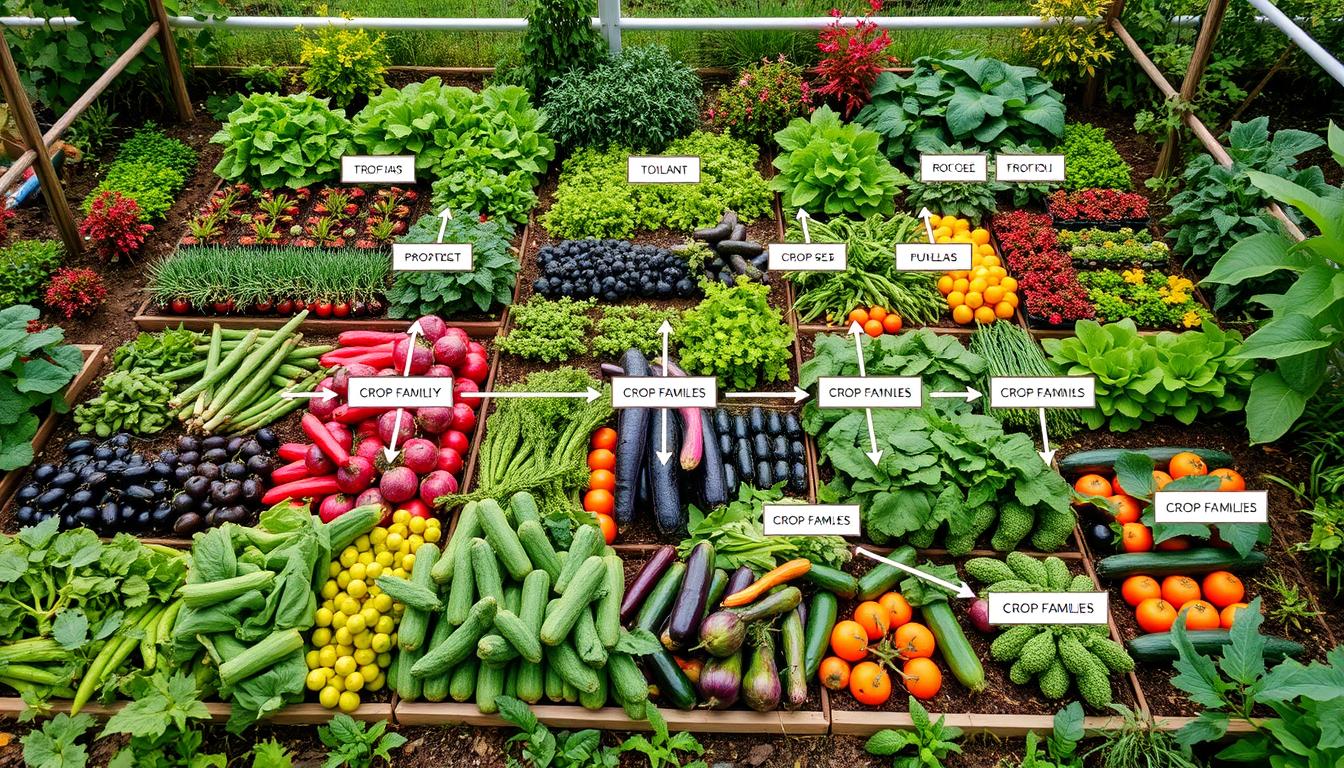I love gardening and know how important it is to keep your garden healthy. A key part of this is using a crop rotation schedule. I’ll show you how to plan a good crop rotation for your garden. This way, your plants will get the nutrients they need, and your garden will stay pest-free and productive.
Key Takeaways
- Crop rotation is essential for maintaining soil health and preventing pest and disease issues in your vegetable garden.
- Grouping crops by plant family and understanding their nutrient requirements is crucial for developing an effective rotation schedule.
- Incorporating cover crops can further enhance the benefits of crop rotation by improving soil fertility and structure.
- Keeping detailed records of your garden’s history and adjusting your rotation plan as needed is key to its long-term success.
- Crop rotation is a fundamental practice for sustainable and productive vegetable gardening.
Understanding the Importance of Crop Rotation
Crop rotation is key in sustainable gardening. It boosts soil health and fights pests. By moving crops to new beds, you make your garden stronger over time.
Benefits of Crop Rotation for Soil Health
Crop rotation keeps soil fertile. Plants need different nutrients, so rotating them prevents soil depletion. This helps plants grow strong and healthy.
It also makes soil better by encouraging microbes. Plant roots make the soil more open, helping it hold water and air better.
Preventing Pest and Disease Buildup
Rotating crops fights pests and diseases. Many pests and diseases can’t live without their favorite plants. By moving crops, you stop them from spreading.
| Benefits of Crop Rotation | Impact |
|---|---|
| Improved Soil Fertility | Ensures balanced nutrient availability for plants |
| Enhanced Soil Structure | Improves aeration, water infiltration, and water-holding capacity |
| Reduced Pest and Disease Pressure | Disrupts the life cycles of plant-specific pests and pathogens |
Understanding crop rotation helps make your garden better. It’s a step towards a sustainable and strong vegetable garden. Using it in your gardening plan keeps your garden healthy and productive for years.
How to Plan a Crop Rotation Schedule for a Vegetable Garden
Creating a good crop rotation plan is key to a successful vegetable garden. It helps keep the soil healthy, reduces pests and diseases, and grows a wide variety of nutritious crops. By planning your planting schedule carefully, you can make your garden more productive and sustainable.
The first thing to do is group your vegetables by family. This makes it easier to see which crops need similar nutrients and are more likely to get pests or diseases. Common families include Brassicaceae (like cabbage and broccoli), Solanaceae (tomatoes and peppers), and Cucurbitaceae (cucumbers and squash).
- Set up your garden beds for a four-year rotation plan. Each bed will be for a different plant family each year.
- Use one bed for heavy-feeding crops like tomatoes and leafy greens in the first year.
- Move that bed to light-feeding crops like onions and brassicas in the second year.
Adding cover crops to your rotation is also beneficial. They add nutrients to the soil, fight weeds, and improve soil structure. This helps keep your garden healthy and productive over time.
| Year 1 | Year 2 | Year 3 | Year 4 |
|---|---|---|---|
| Heavy Feeders | Light Feeders | Legumes | Alliums |
By following these steps, you’ll have a solid crop rotation plan for your garden. Keep track of your plantings and rotate your crops each year. Adjust as needed to tackle any challenges or find new opportunities.
Grouping Crops by Plant Family
Starting a vegetable garden involves understanding different plant families. This knowledge helps manage soil nutrients and prevent pests and diseases. It also makes your garden more balanced.
Root Vegetables
Root crops like carrots, beets, and radishes belong to the Apiaceae and Chenopodiaceae families. They need deep soil and nutrients. It’s important to follow them with different crops to avoid soil depletion.
Leafy Greens
Leafy greens, such as lettuce, spinach, and kale, are in the Asteraceae and Brassicaceae families. They have shallow roots and need lots of nutrients. Rotating them with other vegetables helps keep the soil balanced.
| Crop Family | Example Crops | Nutrient Needs | Rotation Considerations |
|---|---|---|---|
| Apiaceae | Carrots, Parsnips, Celery | Nutrient-rich, well-draining soil | Follow with shallow-rooted crops |
| Chenopodiaceae | Beets, Chard, Spinach | Nutrient-dense, moisture-retentive soil | Rotate with legumes or grasses |
| Asteraceae | Lettuce, Endive, Chicory | Consistent moisture, nutrient-rich soil | Follow with deep-rooted crops |
| Brassicaceae | Kale, Broccoli, Cabbage | Nutrient-dense, well-draining soil | Rotate with non-brassica crops |
Knowing about crop families helps gardeners plan better. It ensures a healthy and productive garden. This knowledge is key to successful vegetable grouping and crop rotation.

Mapping Your Garden Beds
Visualizing your garden beds layout is key to a successful crop rotation plan. Knowing your garden’s size and layout helps you plan where and when to plant. This boosts your garden’s productivity and soil health.
Begin by drawing a diagram of your garden. Note its dimensions, sun exposure, and any fixed features. This will guide you in arranging your raised beds or in-ground areas. Think about:
- Bed size and shape
- Pathways and access points
- Proximity to water sources
- Shaded versus sunny areas
With a clear garden map, you can assign crops to beds. Group similar plants together, like root veggies, leafy greens, and fruiting plants. This makes crop rotation planning easier and supports your garden’s ecosystem balance.
By mapping your garden carefully, you’re setting up for a fruitful harvest season. With some planning, your vegetable garden will thrive, providing for you for years.
Creating a Four-Year Rotation Plan
To create a solid crop rotation plan, a four-year strategy is key. This plan helps you organize your vegetable garden schedule well. It ensures your soil gets the right nutrients and your plants grow strong.
Year One: Heavy Feeders
Start with heavy feeder crops in the first year. These plants need lots of nutrients to grow well. Examples include tomatoes, peppers, eggplants, and leafy greens like kale and spinach.
Year Two: Light Feeders
The second year is for light feeder crops. These plants need less nutrients and help the soil recover. Good choices are carrots, beets, radishes, and legumes like beans and peas.
Switching between heavy and light feeders keeps your garden healthy and fertile for years.
A good vegetable garden schedule boosts your garden’s productivity and sustainability. By planning your crop rotation, you ensure your soil is nourished. This way, your plants get the resources they need to flourish.
Incorporating Cover Crops
Adding cover crops to your garden is a smart move for better soil health. Plants like rye, vetch, and clover are great for your garden. They help make your garden more sustainable.
Benefits of Cover Crops
Cover crops are key to a healthy garden. They improve soil structure, suppress weeds, and help with nutrient cycling. This makes your garden more productive and strong.
- They make the soil better by adding organic matter and improving its structure. This helps with water and keeps it moist.
- They fix nitrogen from the air, making it ready for your next crop. This means you use less synthetic fertilizers.
- They stop soil erosion by covering the ground. This is especially helpful when your garden is not in use.
- They also disrupt pests and diseases. This helps keep your soil healthy and free from harmful organisms.
By using cover crops in your four-year rotation, you get many soil-boosting benefits. Your garden becomes a nutrient-rich environment for your vegetables to grow well.

“Cover crops are the unsung heroes of sustainable gardening, quietly improving soil health and setting the stage for bountiful vegetable harvests.”
Accounting for Companion Planting
When planning your crop rotation, think about companion planting. It’s a natural way to control pests and improve your garden. By pairing plants wisely, you can make your garden more diverse and strong.
Companion planting means growing plants together for their benefits. Some plants keep pests away, attract good bugs, or help other plants grow better. Adding these pairs to your rotation can cut down on chemical use and make your garden healthier.
- Marigolds, nasturtiums, and herbs can keep pests like aphids and whiteflies away.
- Legumes fix nitrogen, which helps plants like tomatoes and corn.
- Tall plants like sunflowers shade and protect smaller companion planting crops.
When planning your crop rotation, think about which plants go well together. Rotate them to make your garden better at managing pests naturally. This way, you’ll have a garden that’s easy to care for and gives you lots of healthy food.
Companion planting is a smart way to use plant relationships in your garden. It makes your garden more diverse and less prone to pests. By using these pairs in your rotation, you’ll have a garden that’s productive and pest-free.
Keeping Records and Adjusting as Needed
Keeping detailed crop rotation records is key for a successful vegetable garden. A garden journal helps track your plans, notes successes and challenges, and guides future seasons.
Your garden journal is a valuable tool. It lets you reflect on past experiences and improve your crop rotation strategy. Note the crops, planting times, and any observations on health, pests, or yield. This helps spot patterns and make your garden more productive and sustainable.
Being adaptable and flexible in your gardening is important. You can tweak your crop rotation plan to meet your garden’s needs. Try new combinations, adjust planting times, and use cover crops to improve soil and control weeds.
Regular garden planning and record-keeping make you a better gardener. You’ll make informed decisions that lead to a successful garden year after year.
| Year | Crop Rotation Records | Observations and Adjustments |
|---|---|---|
| 2020 | Tomatoes, peppers, and eggplants in Bed A; leafy greens and brassicas in Bed B; root vegetables in Bed C. | Experienced a slight decline in tomato yields due to increased pest pressure. Adjusted crop placement for the following year to promote better pest management. |
| 2021 | Leafy greens and brassicas in Bed A; root vegetables in Bed B; tomatoes, peppers, and eggplants in Bed C. | Introduced a cover crop in Bed A after the leafy green harvest, which helped improve soil structure and fertility. Noted a significant increase in overall vegetable yields. |
| 2022 | Root vegetables in Bed A; tomatoes, peppers, and eggplants in Bed B; leafy greens and brassicas in Bed C. | Observed improved pest management and reduced disease issues across all beds. Decided to maintain this rotation plan for the next growing season. |
“Keeping detailed records of your crop rotation plan is essential for understanding the long-term impacts on your garden’s health and productivity.”
Conclusion
Creating a good crop rotation schedule is key for a healthy, productive, and eco-friendly vegetable garden. Knowing the benefits of crop rotation helps you plan and improve your garden. This way, you can grow more, keep your soil healthy, and fight pests and diseases better.
Understanding your plants’ needs and your soil’s makeup is crucial for crop rotation. By arranging your crops wisely, you can use nature’s help and balance your garden’s needs. This makes gardening more sustainable.
A good crop rotation plan is great for your plants and your garden’s health. By following the tips in this article, you start a journey of sustainable gardening. You’ll enjoy plenty of harvests and a balanced ecosystem in your backyard.



Leave a Reply